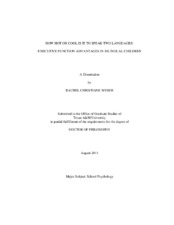| dc.description.abstract | According to the 2009 U.S. Census Bureau, approximately 57 million individuals, ages five and older, living in the United States spoke a language other than English at home. There is a clear and growing number of bilingual individuals and English Language Learners (ELL) in the United States. With these growing numbers, especially within the school-aged population, it is crucial that a clear understanding exist regarding the development of children who are bilingual or learning English as their second language.
There is evidence that bilingual children differ from their monolingual peers in the development of executive function (EF), and specifically demonstrate some advantages on EF tasks. This research has not been expanded to include the new conceptualization of EF as hot and cool. This study seeks to examine bilingual EF advantages in EF in light of this recent conceptualization. A second goal of this study is to identify other psychosocial variables that predict EF in children and, thus, might impact its development. The variables of interest include socioeconomic status (SES), economic stress, parenting practices (e.g., disciplinary practices and relational frustration), and cultural beliefs (e.g., individualism/collectivism).
A sample of 67 bilingual and monolingual English speaking children and their parents/guardians participated in this study. Children completed 4 EF tasks and parents completed a battery which included measures of the psychosocial variables and the BRIEF Parent Form. A MANCOVA model was utilized to examine bilingual differences in EF. Multiple regression models were also used to test for significant predictors of hot and cool EF and general EF (as measured by the BRIEF GEC) among the psychosocial variables.
No significant group differences were found in multivariate analyses. Significant predictors of specific EF measures and hot and cool total scores were identified, including economic stress, age, relational frustration, vertical individualism, and vertical collectivism. These are discussed in light of current literature and clinical applications. | en |


